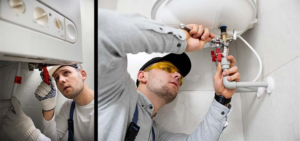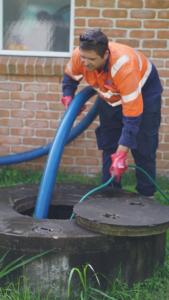Clogging the drains with chemical drain cleaners can damage the pipes in your home. And relying on plungers can bend the pipe walls and cause even more severe blockages.
The solution is professional drain cleaning/clearing. This involves using a high-powered water hose that completely scourges the entire length of the drain piping system. Click the Drain Cleaning Aurora, CO to learn more.

Clogs are a pain and can be very expensive to fix, especially if they lead to serious plumbing problems. The best way to keep drain clogs from happening is to have your drains cleaned on a regular basis.
There is an actual science behind why and how these obstructive oozes form. A combination of things like hair, food, sediment and other debris build up in your pipes over time. When these materials are not properly removed, they create blockages that can cause water to back up into your home or business, resulting in serious damage.
The majority of drain clogs can be prevented with regular drain cleaning services, which remove any built up materials and keep your pipes functioning correctly. Performing routine maintenance like using a strainer to catch hair and other debris in sinks and bathtubs, flushing your drains with hot water on a monthly basis, and avoiding pouring grease down the drain can also help prevent future clogs.
Another important way to prevent clogs is to educate building occupants on proper use of toilets, showers, and drains. Teaching everyone in your home or business to only flush toilet paper, waste and wipes, and to never put coffee grounds or grease down a drain can significantly reduce the likelihood of a costly clog.
While many clogs can be resolved with DIY methods, it is important to recognize when it’s time for professional assistance. Signs that it’s time to call a professional include persistent clogs, foul smells, and gurgling sounds. If a clog is too severe to be fixed with a plunger, a drain snake or auger can be used to break up and retrieve the obstruction.
There are a variety of commercial and residential drain cleaning services available, including hydro jetting, which uses high-pressure water to clean out your entire plumbing system. If your pipe is damaged, rooter services can also be helpful in removing tree roots that have invaded the system. A reputable drain cleaning company will provide these services and more, helping your plumbing last longer and function better than ever before.
Prevents Smelly Odors
A dirty drain or clogged sink is not only smelly, but it can also affect the air quality in your home. The odors come from the stagnant water and bacteria that build up in your pipes and drains. Keeping up with regular drain cleaning prevents these issues and keeps your home smelling fresh.
If you regularly clean your drains with a natural method, such as baking soda and vinegar, or the hot water flush, you can avoid foul odors. This is an easy, effective and inexpensive way to maintain your drains and keep them smelling great.
Another preventative measure you can take is to use strainers or filters to prevent hair, food and other debris from entering the drains. This can help prevent smelly drains in the kitchen, bathroom and shower.
Regularly flushing your drains with boiling water can help as well. This helps break down and wash away any accumulated gunk, grease, soap scum, and other residue. Doing this about three to four times per year can eliminate unpleasant odors and keep your drains in good condition.
There are a variety of commercial drain cleaners on the market. Some are caustic, using a corrosive chemical to break down grease and other residue, but this can also wear away at your pipes. Other cleaners are oxidizing, using a chemical reaction to breakdown and remove clogs. These cleaners are generally safe for your pipes, but they may still emit a strong odor.
If you find that home remedies or store-bought chemical cleaners do not solve the problem of a stinky drain, call a professional for drain cleaning services. These professionals can clear clogs and smelly drains, keeping your home smelling clean and healthy.
Having clean, functioning drains is essential to maintaining your home’s plumbing system. If your home’s drains are starting to smell, contact Reimer for professional drain cleaning services. We’ll ensure your drains are clean and odor-free, so you can enjoy your home to the fullest. Our drain cleaning services are affordable and guaranteed to work! Call today to schedule an appointment.
Prevents Damage to Pipes
When clogs go untreated, they can lead to serious issues that are expensive and time-consuming to repair. Serious clogs can cause wastewater to back up into homes, resulting in water damage to walls, flooring and appliances. Clogged drains also create stagnant water that is a breeding ground for bacteria and mold, which can irritate asthma and other health conditions. Regular drain cleaning prevents these problems and ensures a smooth flow of water through the plumbing system.
Professional drain cleaning methods utilize advanced technology to effectively clean pipes without causing damage or leaving behind residue. These techniques include mechanical drain snakes, hydro-jetting, enzymatic cleaners and video inspection. Professional drain cleaning services can save homeowners and businesses money on costly repairs in the future.
The type of drain pipe in a building dictates which cleaning method is most effective. For example, PVC pipes are non-corrosive and smooth, so they build up less waste and are easier to clean than metal pipes. A professional plumber from Frank Gay Services will use the appropriate method based on the material of the pipes to ensure safe and efficient drain cleaning.
Chemical drain cleaners are highly toxic and can damage the integrity of pipes. Homeowners and business owners can avoid this by practicing preventive maintenance, including using a baking soda and vinegar solution to clear minor clogs and implementing a strainer for all drains in the building. In addition, using a plunger with the correct amount of force will not damage pipe walls.
A clogged drain can also cause a loud, irritating noise that can scare away customers and employees. These squeaking sounds are caused by small particles of food and hair that get caught in the drain, and can be easily prevented with routine drain cleaning.
Backed-up drains are also a safety hazard and can lead to injury for those working around them. Those who perform manual drain cleaning must wear heavy-duty rubber gloves that are resistant to punctures and apprehension, and eye protection such as safety glasses or goggles to prevent contact with biological and chemical contaminants. Those who work with powered drain cleaning equipment, such as hydro-jetting or mechanical drain snakes, should also wear hearing protection to prevent long-term exposure to loud noises.
Prevents Health Issues
Drain cleaning is an important part of maintaining a home plumbing system. It can help prevent blockages, which can lead to clogged pipes, sewer backups and other serious health issues. It can also save you money on expensive repairs and maintenance. Learn more about the benefits of professional drain cleaning, and how to keep your drains clean and functioning properly.
Dirty Drains Cause Unpleasant Odors
One of the most common problems caused by clogged drains is unpleasant odors. These odors come from food particles, soap residue and other debris that build up in your pipes. As the odors spread, they can make your home unpleasant and unhealthy to live in. Regular drain cleaning helps remove these odors and prevent them from returning.
Blocked drains also create the perfect environment for bacterial growth. These bacteria can enter your body through the skin or lungs when inhaled. This can lead to infections, especially for individuals with weakened immune systems. Regular drain cleaning helps prevent these infections by keeping your drains clean and free of debris that can foster bacterial growth.
Standing water in clogged drains can also promote the growth of mold. This can degrade indoor air quality and lead to respiratory problems, headaches and other symptoms. In addition, it can cause allergic reactions in some people. Having your drains cleaned regularly prevents the growth of mold and keeps the water in your drains flowing freely.
Maintaining Clean Drains Helps Prevent Pollution of Water Sources
When drains and sewer lines are blocked, sewage can overflow into the surrounding soil. This contaminates groundwater and nearby bodies of water, causing environmental and health problems. By performing regular drain cleaning and using environmentally friendly chemical cleaners, you can help to prevent these pollutants from entering the water supply.
In addition, neglecting to perform regular drain cleaning can lead to severe pipe clogs and sewage backups. These problems can be extremely messy and costly to resolve. By hiring a professional to perform routine drain cleaning, you can help to avoid these problems and maintain a safe and healthy living environment.



